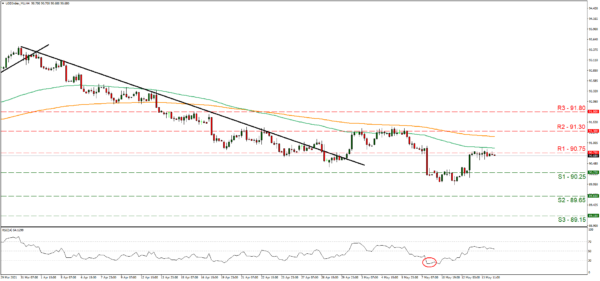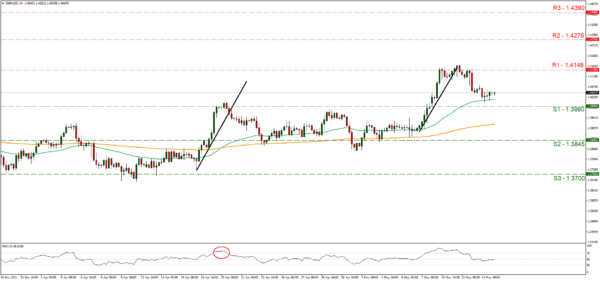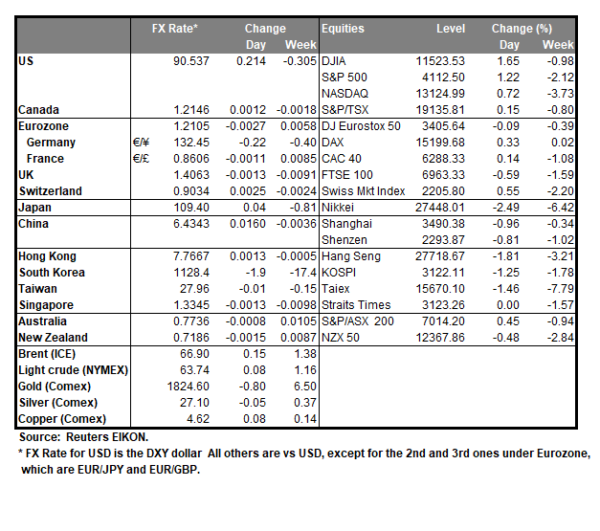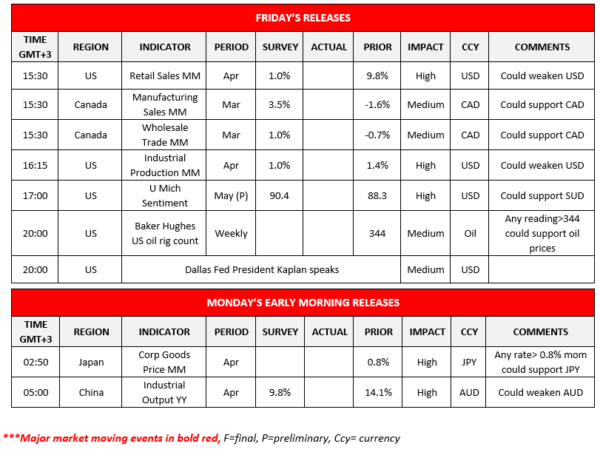The dollar seems to have hit the pause button against a number of its counterparts yesterday in a tight range bound movement as the market is weighing the inflationary pressures in the recovering US economy and increasing the pressure on the Fed to act sooner rather than later. It should be noted that strong readings both on the US PPI rates as well as the weekly initial jobless claims figure failed to provide a further boost for the USD, disappointing USD bullish traders. Also it seems that the Fed is sticking to its dovishness despite the pressure rising for it to tighten its monetary policy, through a tapering of its QE program or an earlier than declared through the dot-plot rate hike. Please note that U.S. bond yields dipped, with the 10-year Treasuries yield slipping to 1.651% after hitting a five-week high of 1.707%. We may see traders today keep an eye out for the US financial releases which could provide further clues regarding the US economic recovery.
The USD index maintain a tight rangebound movement yesterday, hovering just below the 90.75 (R1) resistance line. We tend to maintain a bias for a sideways motion today, given the index’s movement yesterday, yet we note that the RSI indicator below the our 4-hour chart is just above the reading of 50, yet forms a downward slope. Should the bears take the lead over the index’s direction, we may see it aiming if not breaking the 90.25 (S1) support line, on its journey southwards. On the flip side, should the bulls take over, we may see the index breaking the 90.75 (R1) resistance line and aim for the 91.30 (R2) level.
Pound seems to stabilise
The pound rose above $1.41 for the first time since February on the beginning of the week, with cable also being supported by USD weakness, an easing of the market worries about voices for a second Scottish independence referendum, lockdown easing and BoE being more confident. UK GDP rates outperformed market expectations providing support for the GBP, yet a simultaneous strengthening of the USD due to accelerating US inflation rates prevented any rally of cable. On the pound’s fundamentals we would highlight the UK Government’s worries for the spreading of the Indian stem of Covid 19 could increase also the related market worries as the mutation seems to be highly transmittable and if so could weaken GBP. On the other hand, should worries ease, we may see the sterling getting some support. We may see fundamentals taking the lead for the pound given the lack of UK financial releases.
GBP/USD maintain a relatively sideways motion yesterday despite some bearish tendencies midday and remained well between the 1.4145 (R1) and the 1.3990 (S1) levels. Given the pair’s movement yesterday we tend to maintain our bias for a sideways motion and for it to change we would require a clear breaking of either of the prementioned levels. Also please note that the RSI indicator below the 4-hour chart, runs smoothly along the reading of 50, strengthening the notion of a rather indecisive market. Nevertheless, should cable find fresh buying orders along its path, we may see the pair breaking the 1.4145 (R1) resistance line and aim for the 1.4275 (R2) resistance level. Should a selling interest be displayed by the market for GBP/USD, we may see the pair breaking the 1.3990 (S1) support line and aim for the 1.3845 (S2) level.
Other economic highlights today and the following Asian session:
Today in the American session we highlight the release from the US of the retail sales and industrial output growth rates both for April as well as the preliminary University of Michigan consumer sentiment for May, while from Canada we get the manufacturing sales for and wholesale trade growth rates for March. Please note that on the monetary front, Dallas Fed President Kaplan is scheduled to speak while oil traders may also be interest in the release of the weekly US Baker Hughes oil rig count. During Monday’s Asian session, we note the release of Japan’s corporate goods prices for April, while Aussie traders may be more interested in the release of China’s industrial output growth rate for April.
Support: 90.25 (S1), 89.65 (S2), 89.15 (S3)
Resistance: 90.75 (R1), 91.30 (R2), 91.80 (R3)
Support: 1.3990 (S1), 1.3845 (S2), 1.3700 (S3)
Resistance: 1.4145 (R1), 1.4275 (R2), 1.4390 (R3)


















